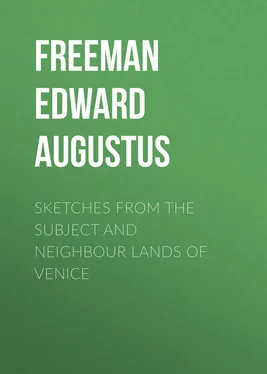Edward Freeman - Sketches from the Subject and Neighbour Lands of Venice
Здесь есть возможность читать онлайн «Edward Freeman - Sketches from the Subject and Neighbour Lands of Venice» — ознакомительный отрывок электронной книги совершенно бесплатно, а после прочтения отрывка купить полную версию. В некоторых случаях можно слушать аудио, скачать через торрент в формате fb2 и присутствует краткое содержание. Жанр: foreign_antique, foreign_prose, Путешествия и география, на английском языке. Описание произведения, (предисловие) а так же отзывы посетителей доступны на портале библиотеки ЛибКат.
- Название:Sketches from the Subject and Neighbour Lands of Venice
- Автор:
- Жанр:
- Год:неизвестен
- ISBN:нет данных
- Рейтинг книги:3 / 5. Голосов: 1
-
Избранное:Добавить в избранное
- Отзывы:
-
Ваша оценка:
- 60
- 1
- 2
- 3
- 4
- 5
Sketches from the Subject and Neighbour Lands of Venice: краткое содержание, описание и аннотация
Предлагаем к чтению аннотацию, описание, краткое содержание или предисловие (зависит от того, что написал сам автор книги «Sketches from the Subject and Neighbour Lands of Venice»). Если вы не нашли необходимую информацию о книге — напишите в комментариях, мы постараемся отыскать её.
Sketches from the Subject and Neighbour Lands of Venice — читать онлайн ознакомительный отрывок
Ниже представлен текст книги, разбитый по страницам. Система сохранения места последней прочитанной страницы, позволяет с удобством читать онлайн бесплатно книгу «Sketches from the Subject and Neighbour Lands of Venice», без необходимости каждый раз заново искать на чём Вы остановились. Поставьте закладку, и сможете в любой момент перейти на страницу, на которой закончили чтение.
Интервал:
Закладка:
Aquileia then, once the greatest city of all, is the city that has come nearest to being altogether wiped out of being. Venice, afterwards the greatest of all, is the city which may most truly be said to have been called out of nothing in after-times. Among the other cities the change has been rather a change of relation and proportion, than a case of absolute birth and death. Cividale is still there, though it is but a poor representative of Forum Julii. Udine has taken its place. But Udine, though its importance belongs wholly to mediæval times, was not strictly a mediæval creation. It is just possible to prove the existence of Vedinum in Roman days, though it is only its existence which can be proved; it plays no part whatever in early history. The case is slightly different with another neighbouring city, the Roman Tarvisium, whose name gradually changed to Treviso . Tarvisium was of more account than Vedinum, but it first comes into notice in the wars of Belisarius, and its position as an important city playing a part in Italian history dates only from the days of the Lombard League. And its general history is one in which the shifting nomenclature of the district may be read with almost grotesque accuracy. It has not only been, like its neighbours, Venetian and Austrian in two widely different senses – it has not only been Venetian in the old geographical sense, and Venetian in the sense of being subject to the commonwealth of Venice – it has not only been Austrian in the old Lombard sense, and Austrian in the sense of being subject to the Dukes of the German Austria – but it has also shifted backwards and forwards between the rule of the Serene Republic and the rule of the Austrian Dukes, in a way to which it would not be easy to find a parallel even among the old revolutions of its neighbours.
Treviso and its district, the march which bears its name, was the first possession of Venice on the true mainland of Italy, as distinguished from that mere fringe of coast along the lagoons which may be more truly counted as part of her dominion by sea. That Treviso lay near to Venice was a truth which came home to Venetian minds at a very early stage of Venetian history. Even in the eleventh century, the earliest authentic chronicler of Venice, that John whose work will be found in the seventh volume of Pertz, speaks with some significance, even when recording events of the time of Charles the Great, of "quædam civitas non procul a Venetia, nomine Tarvisium." When strictly Italian history begins, Treviso runs through the ordinary course of a Lombard city; it takes its share in resistance to the imperial power, it falls into the hands of tyrants of the house of Romano and of the house of Scala. Along with Padua, it is the city which is fullest of memories of the terrible Eccelinò. Won by the Republic in 1338 from its lord Mastino della Scala, the special strangeness of its fortunes begins. The modern House of Austria was already in being; but its Dukes had not yet grown into Emperors, one only had grown into an acknowledged King. They had not won for themselves the crowns of Bohemia or Hungary, though, by the opposite process, one Bohemian king, the mighty Ottocar, had counted Austria in the long list of his conquered lands. But presently Treviso becomes the centre of events in which Austria, Hungary, Bohemia, and the Empire, all play their parts. It is perhaps not wonderful when the maritime republic, mistress of the Trevisan march, vainly seeks to obtain the confirmation of her right from the overlord of Treviso though not of Venice, Charles of Bohemia, King of the Romans and future Emperor. But the old times when Huns, Avars, Magyars, barbarians of every kind, poured into this devoted corner of Italy, seem to have come back, when in 1356 we find Treviso besieged by a Hungarian king. But the Hungarian king is no longer an outside barbarian; he is a prince of the house of Anjou and Paris. If Lewis the Great besieged Treviso, it was not in the character of a new Attila or Arpad; he attacked the now Venetian city as part of the war which he so successfully waged against the Republic in her Dalmatian lands. Not thirty years later we find the Doge Andrew Contarini, with more wisdom perhaps than the more famous Foscari of the next age, considering that to Venice the sea was greater than the land, and therefore commending her new conquest on the mainland to Duke Leopold of Austria. The words of the chronicler Andrew Dandolo are worth remembering. They express the truest policy of the Republic, from which she ought never to have gone astray.
"Ducalis excellentia prudentissima, meditatione considerans proprium Venetorum esse mare colere, terramque postergare; hinc enim divitiis et honoribus abundat, inde sæpe sibi proveniunt scandala et errores."
But Leopold, he who fell at Sempach, had not the same passion for dominion south of the Alps as some of his successors. He wisely sold Treviso to the lord of Padua, Francesco Carrara, from whom, after a moment of doubt whether the prize would not pass to the tyrant of Milan, the Republic won it back after eight years' separation. Henceforward Treviso shared the fate of the other Venetian possessions which gradually gathered on each side of her. Having had for a moment its share of Austrian dominion in the fourteenth century, Treviso was able, in the wars of the sixteenth century, to withstand the same power in a new shape, the power of Maximilian, Austrian Archduke and Roman King. In later times nothing distinguishes the city from the common course by which Treviso and her neighbours became Austrian, French, and Austrian again, till, by the happiest change of all, they became members of a free and united Italy.
In the aspect of the city itself, the Roman Tarvisium has left but small signs of its former being. All that we see is the Treviso of mediæval and later times. The walls, the bell-towers, the slenderer tower of the municipal palace, the arcaded streets, the houses too, though they are not rich in the more elaborate forms of Italian domestic art, have all the genuine character of a mediæval Italian town. Not placed in any striking position, not a hill-city, not in any strictness a river-city, but a city of the plain looking towards the distant mountains – not adorned by any building of conspicuous splendour – Treviso is still far from being void of objects which deserve study. As we look on the city, either from the lofty walk into which so large a part of its walls have been turned, or else from the neighbourhood of its railway station, its aspect, without rivalling that of the great cities of Italy, is far from unsatisfactory. But the character of the city differs widely in the two views. From the station the ecclesiastical element prevails. The main object in the view from this side is the Dominican church of Saint Nicolas, one of those vast brick friars' churches so characteristic of Italy, and to which the praise of a certain stateliness cannot be denied. Saint Nicolas, with its great bell-tower, groups well with the smaller church and smaller tower of a neighbouring Benedictine house. In short, the towers of Treviso form its leading feature, and that, though several of the greatest, above all the huge campanile designed for the cathedral church, have never been finished. In the view from the railway Saint Nicolas' tower is dominant; the tall slender tower of the municipal palace, loftier, we suspect, in positive height, fails to balance it. In the other view, from the wall on the other side, the municipal tower is the leading object, which it certainly would not have been if the bell-tower of the duomo had ever been carried up. There is a great friars' church on this side too, the desecrated church of Saint Francis; but, though a large building with marked outline, it does not stand out at all so conspicuously as its Dominican rival on the other side. The duomo itself, with its eccentric cupolas, goes for less in the general view than either. On the whole, the aspect of Treviso is very characteristically Italian; it would be yet more so if it sent up its one great campanile to mark its site from afar. Still, even as it is, this city of the Lombard Austria proclaims itself as one of the same group as those cities further to the west which we look down on side by side from the castle-hill of Brescia.
Читать дальшеИнтервал:
Закладка:
Похожие книги на «Sketches from the Subject and Neighbour Lands of Venice»
Представляем Вашему вниманию похожие книги на «Sketches from the Subject and Neighbour Lands of Venice» списком для выбора. Мы отобрали схожую по названию и смыслу литературу в надежде предоставить читателям больше вариантов отыскать новые, интересные, ещё непрочитанные произведения.
Обсуждение, отзывы о книге «Sketches from the Subject and Neighbour Lands of Venice» и просто собственные мнения читателей. Оставьте ваши комментарии, напишите, что Вы думаете о произведении, его смысле или главных героях. Укажите что конкретно понравилось, а что нет, и почему Вы так считаете.












